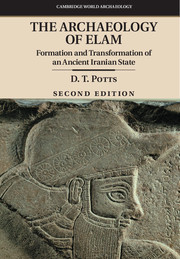Book contents
- Frontmatter
- Dedication
- Contents
- List of illustrations
- List of tables
- Preface to the second edition
- Preface and acknowledgements
- Acknowledgements for photographic reproduction
- List of abbreviations
- Note on transliteration and dating systems
- 1 Elam: what, when, where?
- 2 Environment, climate and resources
- 3 The immediate precursors of Elam
- 4 Elam and Awan
- 5 The dynasty of Shimashki
- 6 The grand regents of Elam and Susa
- 7 The kingdom of Susa and Anshan
- 8 The Neo-Elamite period
- 9 Elam in the Achaemenid empire
- 10 Elymais
- 11 Elam under the Sasanians and beyond
- 12 Conclusion
- References
- Index
6 - The grand regents of Elam and Susa
Published online by Cambridge University Press: 18 December 2015
- Frontmatter
- Dedication
- Contents
- List of illustrations
- List of tables
- Preface to the second edition
- Preface and acknowledgements
- Acknowledgements for photographic reproduction
- List of abbreviations
- Note on transliteration and dating systems
- 1 Elam: what, when, where?
- 2 Environment, climate and resources
- 3 The immediate precursors of Elam
- 4 Elam and Awan
- 5 The dynasty of Shimashki
- 6 The grand regents of Elam and Susa
- 7 The kingdom of Susa and Anshan
- 8 The Neo-Elamite period
- 9 Elam in the Achaemenid empire
- 10 Elymais
- 11 Elam under the Sasanians and beyond
- 12 Conclusion
- References
- Index
Summary
From the era of Shimashki we move to the period of the sukkalmahs, a title of some antiquity in Mesopotamia which has been interpreted variously in its Iranian context. The mechanics of the transformation of the line of Shimashkian kings into the line of Susian sukkalmahs is obscure, but one thing is certain: under the sukkalmahs, particularly those of the late nineteenth and early eighteenth centuries BC, the prestige and influence of Elam throughout Western Asia was unprecedented (see De Graef 2011c for an overview). The break-up of the Ur III empire witnessed the rise of independent, rival dynasties in the southern Mesopotamian cities of Isin and Larsa. Isin's power was greatest during the first three quarters of the twentieth century BC, and this was a period in which the Elamites suffered a series of political and military setbacks. But, beginning in the late twentieth century BC, the power of Isin waned as that of Larsa waxed, and the Elamites came to have substantial influence in the kingdom of Larsa. Ultimately we see Elam emerge as the major powerbroker in a web of relations which bound Assyria, Babylonia and other neighbouring regions, such as Eshnunna (in the modern Diyala River basin) and Mari (on the Middle Euphrates in Syria), often in uneasy alliances which eventually broke down. Elam provided the much-sought-after tin which Mari dispensed to the kingdoms of western Syria and Palestine. Elamite involvement with regions to the south and east, such as Dilmun (Bahrain) and Magan (Oman) in the Persian Gulf, and the resource-rich region of Bactria (northern Afghanistan/southern Uzbekistan), is also documented during this period. While the archaeological evidence of this era is abundant at Susa and in some of the plains of northern and eastern Khuzistan, it is slim in Fars, although several important rock reliefs exist. Ultimately, Hammurabi of Babylon put an end to this phase of growth and influence which saw Elam change from a regional to a world (still in the limited Western Asiatic sense) power.
Introduction
The plurality of royal titles which characterized the later Shimashki period at Susa continued, in altered form, throughout the first half of the second millennium BC, that time referred to as the sukkalmah period.
- Type
- Chapter
- Information
- The Archaeology of ElamFormation and Transformation of an Ancient Iranian State, pp. 148 - 175Publisher: Cambridge University PressPrint publication year: 2015

